
Andrew Collins at Göbekli Tepe in May 2015 (pic credit: Andrew Collins).

Andrew
Collins at Göbekli Tepe in May 2015 (pic credit: Andrew Collins).
GÖBEKLI TEPE, KARAHAN TEPE UPDATE
PLUS THE OPENING OF SANLIURFA'S MAJOR NEW ARCHAEOLOGICAL MUSEUM
A
Report by Andrew Collins
Sunday, May 31st, 2015. I have just returned from southeast Turkey having visited Göbekli Tepe as part of a tour organised by myself and Hugh Newman of Megalithomania. This incredible proto-Neolithic stone temple complex, arguably the oldest of its type in the world, continues to undergo its transformation into an open-air museum. A new visitors' centre is in the process of opening around one kilometre (just over half a mile) from the site, and from this to the main archaeological area a causeway has been built to ferry visitors, presumably in golf carts, to their destination, just like at Stonehenge in England.
On arrival at Göbekli Tepe an elevated wooden walkway navigates the visitor to the main group of enclosures - A, B, C and D. From here they can ascend the hill's summit before being taken to a location where they can overlook the entire mound. Finally, the walkway passes several, much younger, smaller enclosures - including Enclosure F - which line the uppermost area of the mound. Completing the picture will be a massive umbrella-like roof that will replace the rather unsightly temporary wooden structure currently protecting the main enclosures.

1.
Göbekli Tepe's Enclosure D, May 2015 (pic credit: Andrew Collins, 2015).
All this is scheduled for completion in 2016. It will make Göbekli Tepe a major international tourist attraction, highlighting its significance as one of archaeology's most important discoveries in recent years. However, it could be argued that these changes will make it a somewhat sterile site, devoid of life, miles away from the breathtaking archaeological excavations that have taken place here over the past two decades under the leadership of Professor Klaus Schmidt. He was the forward-thinking German archaeologist who rediscovered Göbekli Tepe in 1994, who spent his entire life uncovering the mysteries of this place before his unexpected death in 2014. Further excavations are still taking place, although they are now marganised, confined to an area of the mound well away from the gaze of the public. No longer will visitors be able to see new discoveries as and when they are made.
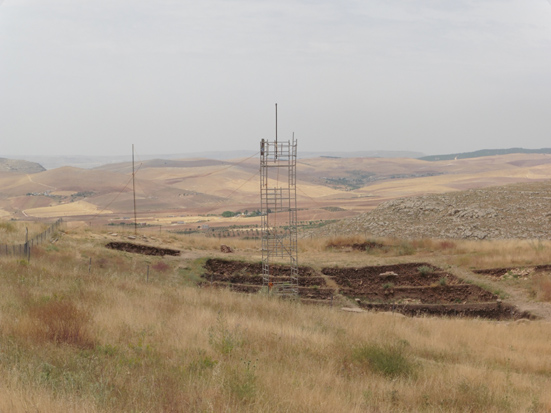
2.
View across to the new excavations at Göbekli Tepe,
May 2015 (pic credit:
Andrew Collins, 2015).
Our tour group visited the site twice - once in the morning and once in the late afternoon as the sun sunk down below the distant Taurus mountains well beyond the ancient city of Sanliurfa. On this second occasion we had the site to ourselves before it finally closed. This was a truly magical experience that allowed us to wander among the enclosures, marvelling at these incredible feats of engineering, and discussing new observations and theories.
I suspect that such tranquillity at the site might be more difficult to achieve when its transition into Anatolia's Stonehenge is complete. So if you want to experience Göbekli Tepe as it really is, an archaeological site of extraordinary magnificence and beauty, now is the time. We are returning there in September for the same experience and would love to have you along on the journey.
Sanliurfa's
New Museum
One other major reason to visit Göbekli Tepe right now is Sanliurfa's new archaeological museum. This opened to the public for the first time on May 27, just two days before our own visit. Located just a stone's throw from our hotel (indeed, it was the main view from the window of my room), it is massive - a huge modern looking building the size of a Walmart superstore. I had heard rumours of what it might contain, but was absolutely blown away by what we actually found.

3.
Sanliurfa's new archaeological museum
(pic credit: Andrew Collins, 2015).
After passing through a rather modest, but beautifully recreated, section on the Palaeolithic age in southeast Turkey, the visitor enters a hall containing hundreds of exhibits from the excavations at Göbekli Tepe and other Pre-Pottery Neolithic sites in the region, including Nevali Çori. This was a major archaeological site in the extreme north of Sanliurfa province drowned beneath the rising waters of the Euphrates river in 1992 following the opening, two years earlier, of the Ataturk dam. Items that I have only ever seen in books were on display to the public for the first time ever.
Aside from the famous Urfa Man, a lifestyle stone statue of a bald-headed individual with eyes of obsidian found in Sanliurfa in the early 1990s, the room contained the stone head with snake-like ponytail found at Nevali Çori, as well as various stone totem posts from both here and Göbekli Tepe. We also saw the stone slab bearing a carved image of what is known as the "Göbekli goddess," actually a crone-like woman with sagging breasts, crescent-shaped head and legs open to display her pudenda. There is also an assortment of mini T-shaped stones, lots of other stone heads, dozens of carved animals, various small goddess statues, as well as a fragment of a stone bowl showing two individuals dancing with an upstanding turtle found at Nevali Çori.
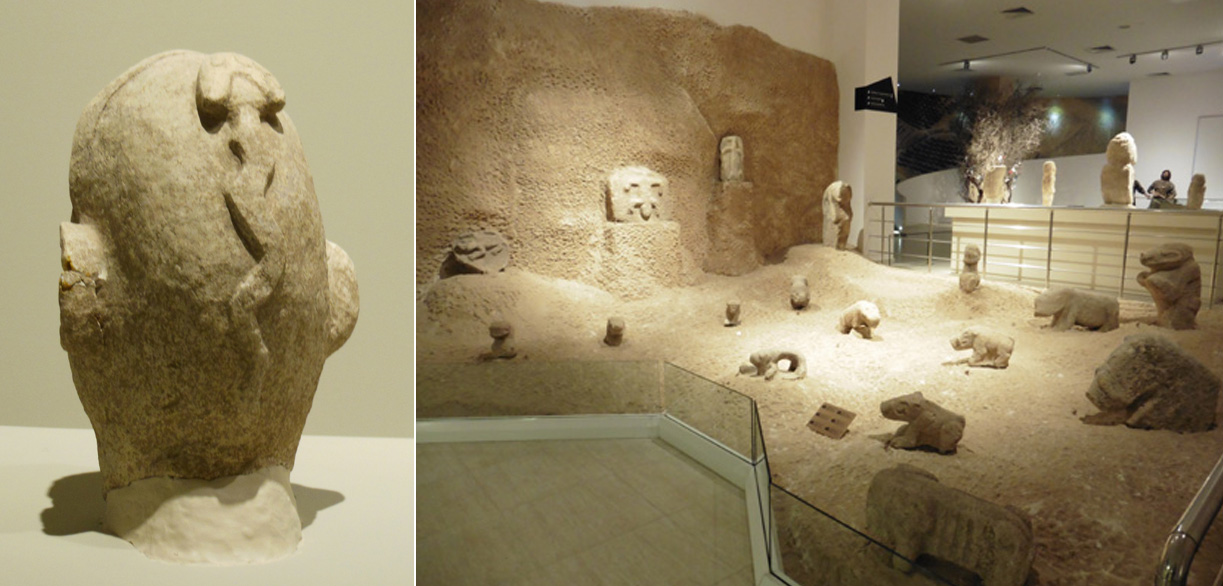
4
& 5. Left, the strange head with serpent ponytail found at Nevali Çori
and, right,
an assortment of carved animals found at Göbekli Tepe (pic
credits: Andrew Collins, 2015).
After this the visitor is funneled along a long, intentionally darkened walkway, its walls adorned with illuminated images of some of the creatures found carved on the T-shaped stones at Göbekli Tepe. You then turn into a room that simply takes your breath away. Here, in all its glory, is a recreation of Göbekli Tepe's Enclosure D, complete with its ring of twelve T-shaped pillars and twin central monoliths, which stand a full 5.5 metres (18 feet) in height. Positioned centrally in the wall immediately beyond this towering gateway is the holed stone that acts as the enclosure's central focus. It is this holed stone, along with another like it in Göbekli's Enclosure C, that finally convinced me that these megalithic structures, the earliest perhaps in the world, were aligned through these circular apertures towards the stars of the northern horizon. This was the direction of Heaven and the Primal Cause in the beliefs and practices of the Sabians, the ancient star worshippers of nearby Harran, whose origins, I argue elsewhere, almost certainly go back to the age of Göbekli Tepe.

6.
Reconstruction of Göbekli Tepe's Enclosure D in Sanliurfa's
new archaeological
museum (pic credit: Andrew Collins, 2015)
Having
experienced this extraordinary recreation you carry on into another large hall
containing many more objects from Göbekli Tepe and Nevali Çori, including
a stone ring found by Klaus Schmidt in 1995, and proposed by him to be a seelenloch,
or soul hole, once positioned within the wall of a new vanished enclosure. This
was one item I had only ever seen before in photographs. The similarity in size
between this stone ring's aperture and those of the holed stones in Göbekli's
Enclosures C and D make it certain they all most likely functioned as soul holes.
Their presence would have enabled the spirits of the shaman when in an altered
state of consciousness or, indeed, those of the newly deceased to pass freely
through these holes, which feature also in megalithic structures across the ancient
world.
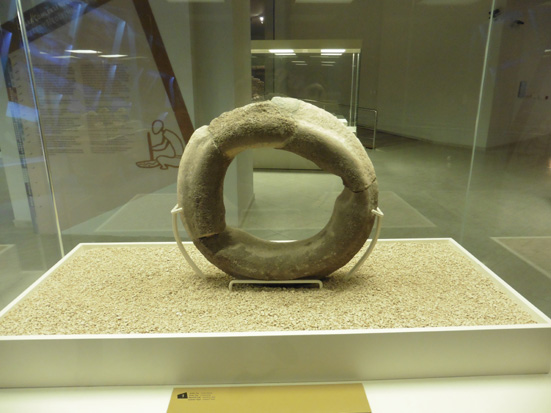
7.
The stone ring found at Göbekli Tepe and suggested by Klaus Schmidt to be
a
seelenloch, a "soul hole" (pic credit: Andrew Collins, 2015).
Then came another breathtaking surprise. Off to one side of this large hall is a stone-by-stone reconstruction of Nevali Çori's own cult building or temple. Standing at its centre is its one remaining twin monolith, which bears an uncanny likeness to the obsidian pillar that appears at the beginning of Stanley Kubrick's classic movie "2001 - A Space Odyssey." And this reconstruction is for real. It is not a fake. It is the actual cult building that was dismantled and removed before the site was finally drowned. Never before has it been seen in public.
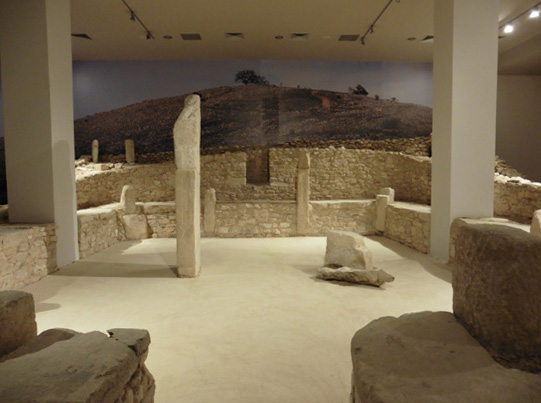
8.
Reconstruction of Nevali Çori's cult building in Sanliurfa's
museum
(pic credit: Andrew Collins, 2015).
Down Through the Ages
Once through the museum's Pre-Pottery Neolithic section you come forward in time, entering the era in which ceramics, and finally metal, flourished in southeast Anatolia. This was the period of the Halaf culture and they are represented in an entire room dedicated to the Chalcolithic or Copper Age. There are countless examples here of the Halaf culture's technological and artistic achievements, including some beautifully decorated pottery and various examples of obsidian blades, which are among the sharpest in the world.
If you still have the mental capacity to take in more there are halls dedicated to the Bronze Age, the Iron Age, the Roman period, and, finally the Islamic age. These final sections contain many items from the city of Harran, located to the south of Sanliurfa. Its inhabitants, the Sabians or Chaldeans, were among the world's first astronomers and astrologers, and here too was a temple for the worship of the moon god Sin.

9.
Basalt stela from Harran showing King Nabonid
praising the sun, moon and stars,
ca. 5-6th century BC
(pic credit: Andrew Collins, 2015).
By the end of the visit my head was spinning, and yet I realised that I could not leave it there. I had to go back in time to the Palaeolithic Age and start the journey all over again. I needed to photograph many more items in the Pre-Pottery Neolithic halls, and also experience once more the extraordinary reconstruction of Göbekli Tepe's Enclosure D. The only slightly frustrating thing about this chronological passage through time is that it is one way only. The museum guards want you only to go forward, never back in time, meaning that I had to hurriedly experience every period of history again in order to exit the building, an experience that was pleasant but extremely tiring at the same time.
This aside there is no question that for megalithomaniacs worldwide this is your museum. There is nothing quite like it, for it brings alive the vision of a lost civilization in a way utterly unique to the modern world. It has to be experienced to be believed, and the fact that it is still brand new only enhances that experience.
Karahan
Tepe Discoveries
Among the other sites we saw were the Pools of Abraham and the cave shrine where the Old Testament prophet is said to have been born. These are located in the Bal?kl?göl area of Sanliurfa ancient city, where also the 11,000-year-old Urfa Man was found in the 1990s. We visited also the ruins of the ancient city of Harran, with its famous astronomical tower, the role model some believe for the Tower and Moon cards of the Tarot pack.
We visited also Karahan Tepe, Göbekli Tepe's so far unexcavated sister site. Here our tour party spent their time discovering new alignments of standing stones, their T-shaped heads seen only just peaking out from beneath the earthern surface of the limestone hilltop. Nearby we found clusters of cup marks and much larger eye holes bored out of the exposed bedrock. Others inspected the 5.5 metre (18 feet) long unfinished monolith, as one of the sons of the farmer who owns the land pointed out previously unrecorded features, such as two filled in rock shelters on the hill's south western slope.
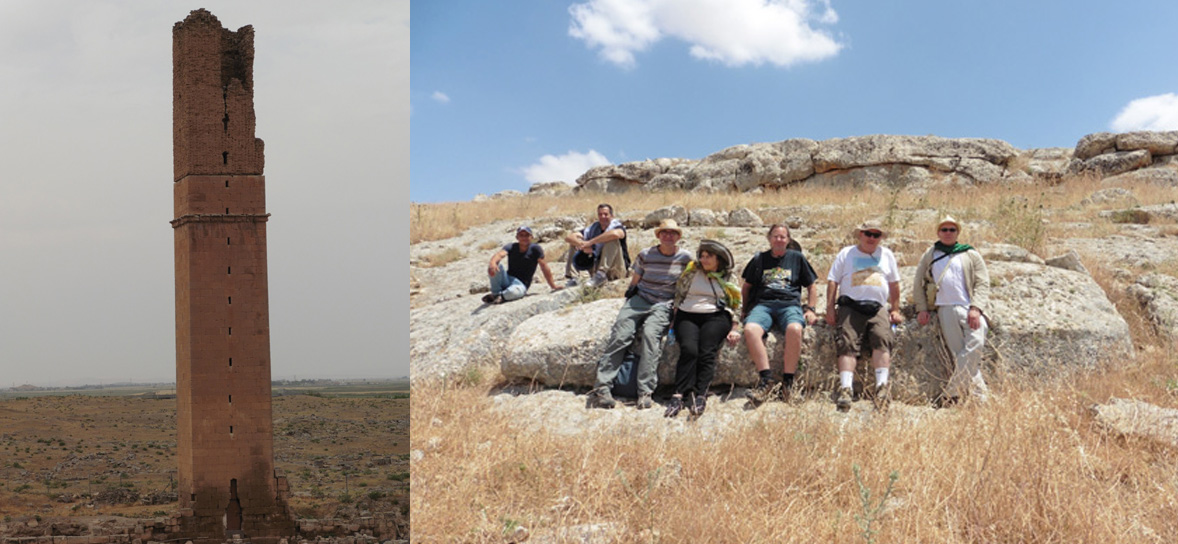
10
& 11. Left, the astronomical tower at Harran and, right, the tour group on
the
unfinished monolith at Karahan Tepe (pic credits: Andrew Collins, 2015).
After enjoying Turkish tea at the local farmhouse, myself and two members of the party, Daniel Giamario and David Malcolm, went to explore another local tepe, or hill, called Keçili, a Kurdish toponym that has connotations of "woman," "daughter" and even "queen." It would have been over this hill, as viewed from nearby Karahan Tepe, that the bright star Deneb would have been seen to set during the timeframe of the megalithic complex's construction, ca. 8500-8000 BC.
Here, in Keçili Tepe, I had been told, were caves large enough to house cows during a harsh winter. These I had to see as there had to be some chance they were seen as entrances to the otherworld by the Pre-Pottery Neolithic peoples that occupied this location. The first example we came across had a slim, sunken entrance that one had to squeeze through to enter.
David Malcolm and I made the decision to explore this natural rock fissure. We crawled like moles through narrow passageways for a distance of perhaps 15 to 20 metres (50 to 65 feet) before giving up, having found nothing of interest.
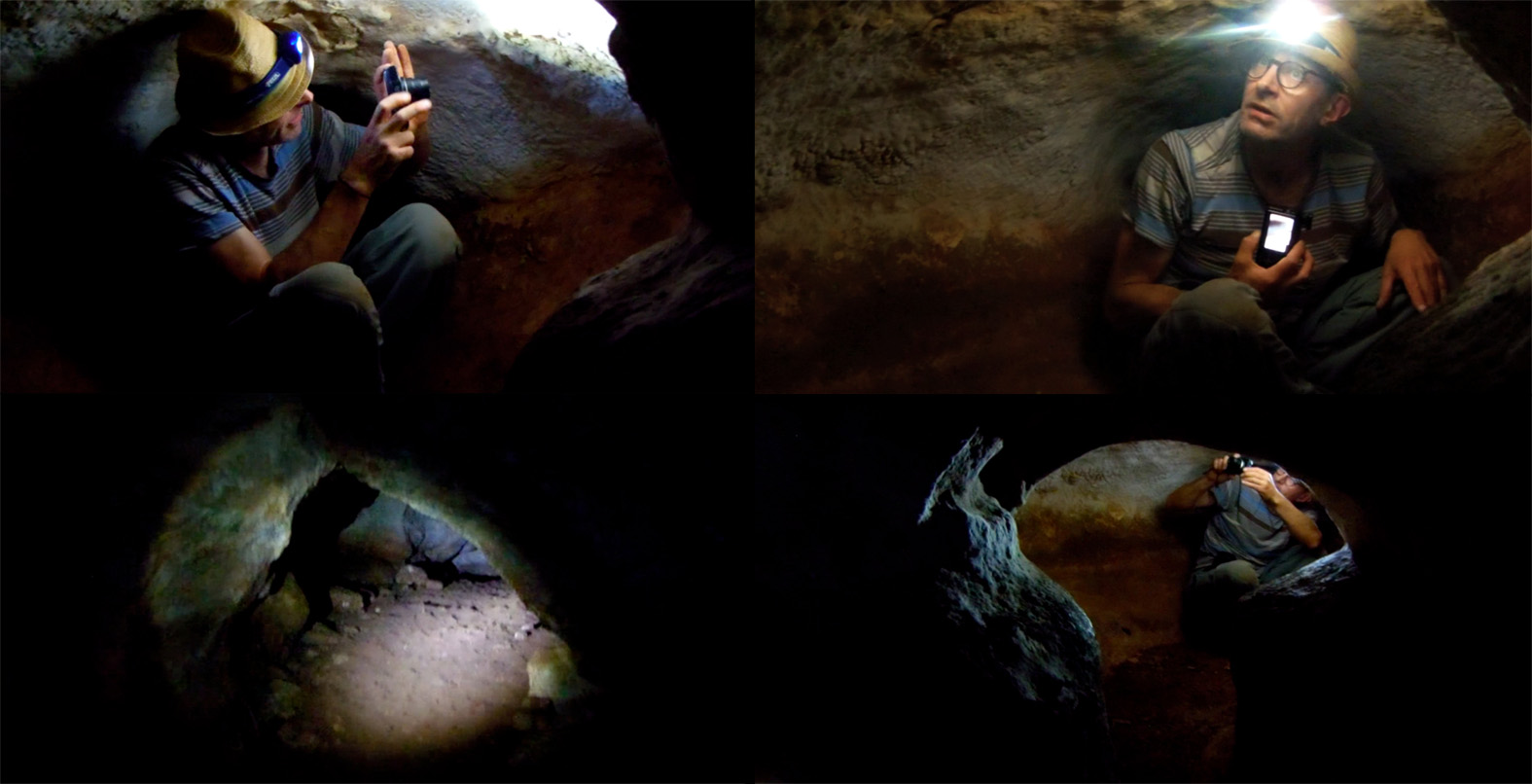
12.
Four views of the natural rock fissure explored (pic credits: Andrew Collins,
2015).
Not far away we inspected a deep well cut into the bedrock. On this had been placed a large megalithic slab with a perfectly carved hole through its centre. Although this hole was functional, allowing a bucket to be lowered on a rope to collect water, the shape of the stone reminded me of the examples at Göbekli Tepe. It made me wonder whether this slab was in secondary use and had originally been part of a megalithic structure. This remains a distinct possibility.
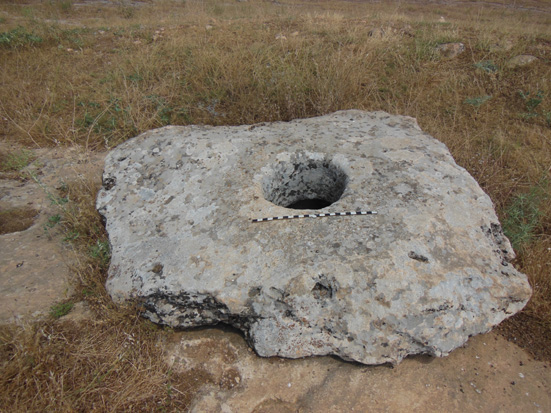
13.
Stone slab with a hole covering the well at Keçili Tepe.
Measure in
inches.(pic credit: Andrew Collins, 2015).
Beehive
Cave
Also close to the first cave explored was a deep beehive structure cut out of the bedrock (designated the name Beehive Cave or BC 1), its only visible point of access being an overhead hole around 0.75 metres (2.5 feet) in diameter. A measuring device showed that the drop from the opening to the covering of rock debris at the bottom of the shaft was around 2.3 metres (7.5 feet). The diameter at the base of shaft was just a little more than the height, so perhaps around 3 metres (9.5 feet). The walls of the chamber seemed purposely rounded, suggesting that they had been artificially enhanced in some manner, perhaps from an existing natural cave chamber. Clearly, it was a place you would not have been able to climb out of easily, a fate that had befallen a few animals whose skeletal remains lay scattered about between the rock debris at the base of the structure.
What exactly the function of this beehive chamber might have been, and who created its circular entrance hole and rounded walls remains unclear. One suggestion put to me is that the structure was created for the purposes of underground grain storage, a large stone being placed over the hole to both seal and disguise its location. This explanation remains a possibility, especially as underground grain storage inside small pits was once practised in Turkey. Yet surely access to the chamber would have been difficult, with its small entrance hole and steep drop to the ground. Plus why put it on the upper slopes of a hill, when any kind of settlement would have been in the valley below, like it is today? Obviously, its remote position would have meant that the site is unlikely to have been discovered by marauders, but was there an alternative explanation?
One possibility is that the beehive chamber served a ritual or ceremonial function, its circular opening allowing the light of the celestial bodies to enter inside. Elsewhere in Turkey stone-built circular structures with small overhead circular apertures known as tholoi were created during the Bronze Age as places of burial. In addition to this, beehive-shaped caves such as the example at Royston in southern England are of a similar size and design to the one on Keçili Tepe in Turkey.
The Royston Cave was carved out of the soft chalk bedrock and has a small circular aperture and rounded walls adorned with carved relief of a highly symbolic and religious nature. No one knows who constructed it, although one persisting theory is that it dates to medieval times and was carved out by Knights Templar, who used it for ceremonial purposes. This, however, might not be the case. Arguably the structure predates the Knights Templar by hundreds if not thousands of years. Did Keçili Tepe's own beehive cave function in a similar manner? Only further investigation will determine its true origin and purpose.

14
& 15. Left, the entrance to the beehive cave on Keçili Tepe and, right,
a glance inside the beehive structure.
Note the regularity of the circular
aperture and interior structure (pic credits: Andrew Collins, 2015).
Two
More Caves
Two more caves were located on Keçili Tepe's western slope. The entrance to one (designated Western Slope or WS1) is clearly carved with a rounded top and straight sides. It easily allows access into a fairly large chamber, which although natural in origin has been deliberately enhanced in its northwest and southwest corners to create a crude rectilinear finish. The chamber is about 9 metres (30 feet) across, with an internal height of around 3 metres (10 feet). There are several small niches in the walls that originally held lamps of some kind, plus there is a larger niche in the east wall, used perhaps either as a seat or as an altar area. An opening in the eastern wall leads into a further chamber, smaller than the first, but also quite possibly enhanced in some manner.
Presumably this was one of the caves that the local farmer used to house his cows during harsh winters. Certainly, there was a stench of animals hanging in the air, while thick layers of soot on the ceiling indicated continual usage over a long period of time (this had not been present in the narrower cave designated WS1 entered earlier).
I attempted to explore the inner chamber but was beaten back by hundreds of flying bugs that seemed unhappy by my presence in their natural habitat. Indeed, the longer I stayed, the more determined they became to make life difficult for me, forcing a rapid retreat into the opening chamber.
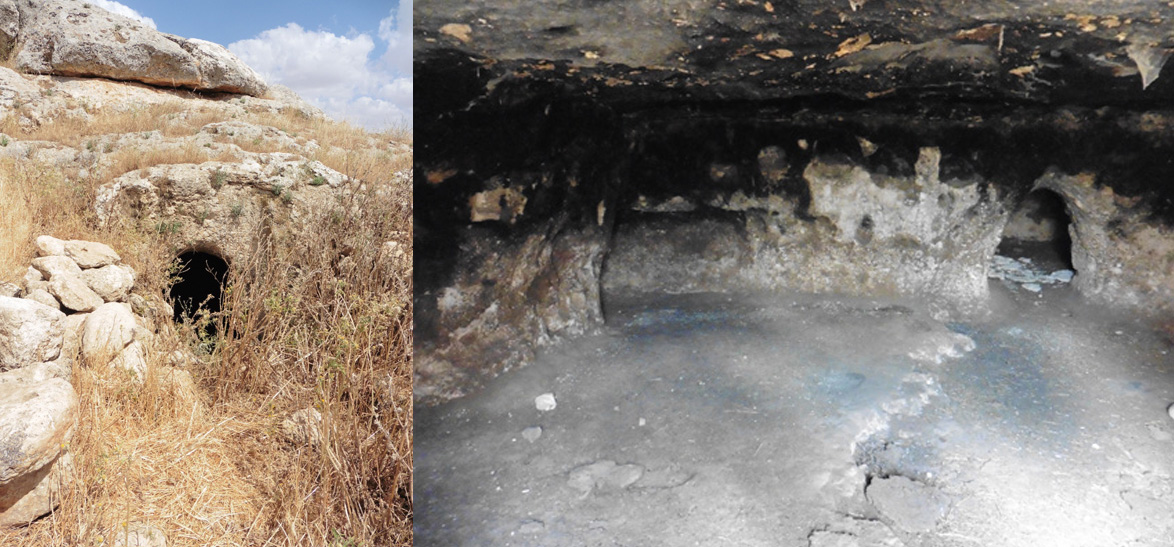
16
& 17. Left, the entrance to Keçili Tepe's cave WS1 and, right, its
opening chamber (pic credits: Andrew Collins, 2015).
In the small amount of time I spent inside the cave I saw no obvious signs that its enhancement had been done by the Pre-Pottery Neolithic community of nearby Karahan Tepe. That's not to say they did not make use of the cave, only that they may not have been responsible for shaping it into its present form. Indeed, on the bedrock in front of the cave I noticed very few stone flints, just a few flakes of indeterminate age. What I did note, however, were scatterings of ceramic fragments that seemed to range from the Bronze Age through to the Islamic period. This appeared to confirm usage of the cave over a very long period of time. Indeed, my best guess right now is that its enhancement dates to the Bronze Age, ca. 3300-1200 BC. What its function might have been is unknown, although the large niche on the east wall of the opening chamber might indicate some kind of ritual or ceremonial activity. It is even possible that it acted as a tomb at some point.
A further cave (designated Western Slope or WS2) existed just 15 metres (50 feet) to the north of the one mentioned above. It also has an enhanced entrance, and inside this was an opening chamber that seemed larger and more spread out than its neighbour. I saw several large niches in the walls, perhaps used as seats, and further evidence of fire lighting on the ceiling. As with its neighbour, there was a smaller chamber off to the east, although once again swarms of bugs forced me to retreat before a proper exploration could be made. Plus it was pointed out that on the ceiling was a small bees' nest, and that we needed to proceed cautiously in here. Since they were the natural site guardians, I abided with their wishes and withdrew, knowing that we had now to return back to the farmhouse to rejoin the rest of the tour party who patiently awaiting our return.
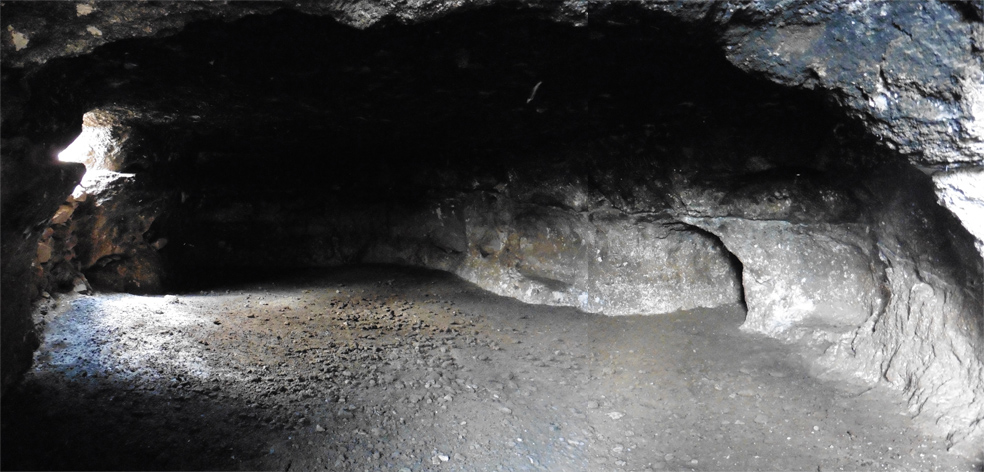
18.
Composite image of The interior of Keçili Tepe cave WS 2 (pic credit: Andrew
Collins, 2015).
Yet our local guide still had more to show us. He pointed out an area of soil where two unenhanced stone blocks stood upright at right angles to each other. He, at least, believed they formed part of a megalithic structure. I was sceptical, but withdrew my scepticism slightly when he pointed out, immediately to the east of these stones, an area of bedrock that had been purposely removed to leave behind a small rectangular cutting around two metres square. He showed us that this cutting, which faces west, was in perfect alignment with the two stones at right angles to each other. In addition to this, there were even further stones, with only their upper surfaces visible at ground level, which seemed to conform to this same east-west alignment. Was this an enclosure linked in some manner with the Pre-Pottery Neolithic complex of Karahan Tepe? I had no answers. Only further exploration will reveal more about this location. I did notice a few worked flakes in the vicinity, but not enough to convince me that this truly was a site of Neolithic origin.
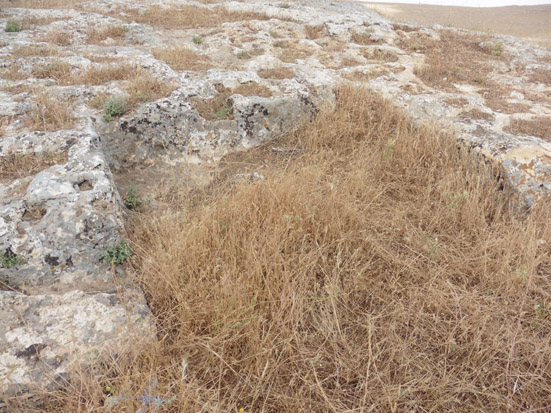
19.
Section of bedrock removed to leave a rectangular cut section on the
western
slopes of Keçili Tepe (pic credit: Andrew Collins, 2015).
On the way back to the farmhouse the guide pointed out a roughly circular entrance cut into the bedrock, which led into yet another underground chamber of some kind. However, the opening was not really circular, and so could easily have been natural. Any investigation of this site would have to wait until a return visit, for more immediate concerns were now at the forefront of my mind. It was mid afternoon, and there was still that second visit to Göbekli Tepe ahead of us on the way back to Sanliurfa. This, as I have already said, provided a perfect ending to what had been an incredible journey of discovery and exploration.
I look forward to continuing that journey in September.
Safety
Issues
One point that has to be raised is the matter of safety. Many people are worried that the troubles over the border in Syria are affecting daily life in southeast Turkey. Nothing can be further from the truth. I saw, nor heard, nothing that might cause concern, and can confirm that life continues as normal in this part of the world. There is no trouble whatsoever in southeast Turkey, and nor is any expected. If it was, then there is no way the Turkish Government would be opening a new multi-million dollar archaeological museum in Sanliurfa, and converting Göbekli Tepe into an open-air museum.
What should be remembered is that although Turkey is an Islamic country, its inhabitants universally denounce the warped ideologies of the extremists in Syria and Iraq. Indeed, they look in the main towards Western society for inspiration. Nowhere in southeast Anatolia did I feel any kind of animosity towards either myself or the tour group, nor did we see anything out of the ordinary. Here in southeast Anatolia Turks, Kurds and Arabs live together peacefully, side-by-side, and that same hospitality is extended to all foreign visitors who come to visit their country.
So do not be put off by what you read, hear or see in the news media. It is safe to come to southeast Turkey and visit these most beautiful of places, which are crucial to our understanding of the origins of civilization.
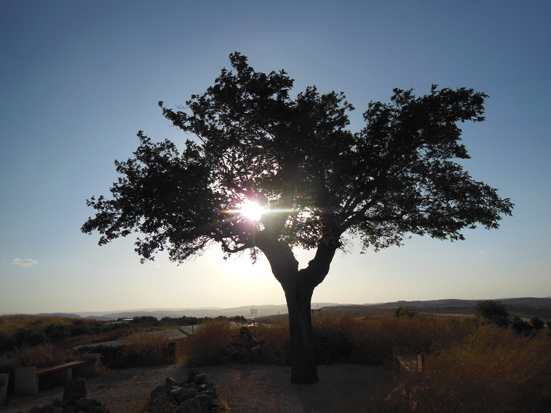
20.
The mulberry tree on the summit of Göbekli Tepe
(pic
credit: Andrew Collins, 2015).